Innovations in Green Concrete: Combining Metakaolin and Arundo Grass Biochar for Enhanced Sustainability
Abstract
1. Introduction
2. Materials and Methods
2.1. Materials
2.1.1. Arundo Grass Biochar
2.1.2. Metakaolin
2.1.3. Portland Cement
2.1.4. Coarse and Fine Aggregates
2.2. Concrete Mixture Preparation
2.3. Testing
2.3.1. Bulk Density, Absorption, and Volume of Voids
2.3.2. Compressive Strength
2.3.3. Sorptivity
2.3.4. Cabon Reduction
2.3.5. Statistical Analysis
3. Results
3.1. Bulk Density, Absorption, and Volume of Voids
3.2. Compressive Strength
3.3. Sorptivity
3.4. Carbon Emissions Reduction
4. Conclusions
- Substituting cement with biochar reduced the 28-day density of concrete. However, adding metakaolin significantly increased the density due to its finer particle size and pozzolanic reactivity, which enhanced the microstructure and mechanical properties of the concrete. The combination of biochar and metakaolin also improved impermeability by reducing absorption and void content, thereby enhancing the overall quality of the concrete.
- Incorporating 5% biochar reduced the compressive strength of concrete. However, the addition of 10% metakaolin significantly improved strength, achieving levels comparable to the control. This finding indicates that higher metakaolin content can offset the negative effects of biochar, contributing to better density and mechanical performance.
- The inclusion of 5% biochar decreased the initial rate of absorption and improved long-term durability by forming a denser and less permeable matrix. Conversely, metakaolin increased the initial absorption rate due to its fine particle size and reactivity but refined the pore structure over time through pozzolanic reactions. This complementary behavior highlights the potential of combining biochar and metakaolin to optimize both early-age performance and long-term durability, offering a balanced approach to sustainable construction materials.
- A significant reduction in CO2 emissions was achieved with biochar-incorporated concrete and further enhanced by metakaolin supplementation. This underscores the potential of biochar and metakaolin as synergistic components in low-carbon concrete technologies that balance.
5. Future Work
Author Contributions
Funding
Data Availability Statement
Acknowledgments
Conflicts of Interest
References
- Miller, S.A.; Horvath, A.; Monteiro, P.J.M. Readily implementable techniques can cut annual CO2 emissions from the production of concrete by over 20%. Environ. Res. Lett. 2016, 11, 074029. [Google Scholar] [CrossRef]
- Ramsden, K. Cement and Concrete: The Environmental Impact. Available online: https://psci.princeton.edu/tips/2020/11/3/cement-and-concrete-the-environmental-impact (accessed on 12 June 2024).
- Garside, M. Cement Production Worldwide from 1995 to 2022. Available online: https://www.statista.com/statistics/1087115/global-cement-production-volume/#statisticContainer (accessed on 12 June 2024).
- Little Ways to Make Big Reductions in Cement Sector Emissions. Available online: https://www.c2es.org/2024/02/little-ways-to-make-big-reductions-in-cement-sector-emissions/ (accessed on 18 December 2024).
- Akhtar, A.; Sarmah, A.K. Novel biochar-concrete composites: Manufacturing, characterization and evaluation 508 of the mechanical properties. Sci. Total Environ. 2018, 616–617, 408–416. [Google Scholar] [CrossRef] [PubMed]
- Fawzy, S.; Osman, A.I.; Yang, H.; Doran, J.; Rooney, D.W. Industrial biochar systems for atmospheric carbon removal: A review. Environ. Chem. Lett. 2021, 19, 3023–3055. [Google Scholar] [CrossRef]
- Tan, K.; Pang, X.; Qin, Y.; Wang, J. Properties of cement mortar containing pulverized biochar pyrolyzed at different temperatures. Constr. Build. Mater. 2020, 263, 120616. [Google Scholar] [CrossRef]
- Zimmer, A.T.; Weitz, K.; Padhhye, A.; Sifleet, A.; Gabriele, H. Wood Waste Inventory: Final Report; U.S. Environmental Protection Agency: Washington, DC, USA, 2018. [Google Scholar]
- Manić, N.; Janković, B.; Stojiljković, D.; Popović, M.; Cvetković, S.; Mikulčić, H. Thermodynamic study on energy crops thermochemical conversion to increase the efficiency of energy production. Thermochem. Acta 2023, 719, 179408. [Google Scholar] [CrossRef]
- Jia, Y.; Li, H.; He, X.; Li, P.; Wang, Z. Effect of biochar from municipal solid waste on mechanical and freeze–thaw properties of concrete. Constr. Build. Mater. 2023, 368, 130374. [Google Scholar] [CrossRef]
- Ling, Y.; Wu, X.; Tan, K.; Zou, Z. Effect of Biochar Dosage and Fineness on the Mechanical Properties and Durability of Concrete. Materials 2023, 16, 2809. [Google Scholar] [CrossRef]
- Revathi, S.; Tania, D.A.E.; Shadin, S.A.; Keerthana, J. Effect of zeolite and bamboo biochar as CO2 absorbent in concrete. Carbon Res. 2024, 3, 43. [Google Scholar] [CrossRef]
- Asadi Zeidabadi, Z.; Bakhtiari, S.; Abbaslou, H.; Ghanizadeh, A.R. Synthesis, characterization and evaluation of biochar from agricultural waste biomass for use in building materials. Constr. Build. Mater. 2018, 181, 301–308. [Google Scholar] [CrossRef]
- Gupta, S.; Kua, H.W.; Low, C.Y. Use of biochar as carbon sequestering additive in cement mortar. Cem. Concr. Compos. 2018, 87, 110–129. [Google Scholar] [CrossRef]
- Chen, L.; Zhang, Y.; Wang, L.; Ruan, S.; Chen, J.; Li, H.; Yang, J.; Methacholine, V.; Tsang, D.C.W. Biochar-augmented carbon-negative concrete. Chem. Eng. J. 2022, 431, 133946. [Google Scholar] [CrossRef]
- Azzi, E.S.; Karltun, E.; Sundberg, C. Life cycle assessment of urban uses of biochar and case study in Uppsala, Sweden. Biochar 2022, 4, 18. [Google Scholar] [CrossRef]
- Chen, T.; Zhao, L.; Gao, X.; Li, L.; Qin, L. Modification of carbonation-cured cement mortar using biochar and its environmental evaluation. Cem. Concr. Compos. 2022, 134, 104764. [Google Scholar] [CrossRef]
- Pecha, B. Biochar as a Building Material: Sequestering Carbon and Strengthening Concrete. Available online: https://www.nrel.gov/docs/fy22osti/82445.pdf (accessed on 11 May 2024).
- Praneeth, S.; Guo, R.; Wang, T.; Dubey, B.K.; Sarmah, A.K. Accelerated carbonation of biochar reinforced cement-fly ash composites: Enhancing and sequestering CO2 in building materials. Constr. Build. Mater. 2020, 244, 118363. [Google Scholar] [CrossRef]
- Gupta, S.; Kua, H.W. Combination of Biochar and Silica Fume as Partial Cement Replacement in Mortar: Performance Evaluation Under Normal and Elevated Temperature. Waste Biomass Valorization 2019, 11, 2807–2824. [Google Scholar] [CrossRef]
- Mishra, G.; Danoglidis, P.; Shah, S.P.; Konsta-Gdoutos, M. Optimization of biochar and fly ash to improve mechanical properties and CO2 sequestration in cement mortar. Constr. Build. Mater. 2023, 392, 132021. [Google Scholar] [CrossRef]
- Gupta, S.; Krishnan, P.; Kashani, A.; Kua, H.W. Application of biochar from coconut and wood waste to reduce shrinkage and improve physical properties of silica fume-cement mortar. Constr. Build. Mater. 2020, 262, 120688. [Google Scholar] [CrossRef]
- Gelb, L.D.; Gubbins, K.E.; Radhakrishnan, R.; Sliwinska-Bartkowiak, M. Phase separation in confined systems. Rep. Prog. Phys. 1999, 63, 727. [Google Scholar] [CrossRef]
- Winters, D.; Boakye, K.; Simske, S. Toward Carbon-Neutral Concrete through Biochar–Cement–Calcium Carbonate Composites: A Critical Review. Sustainability 2022, 14, 4633. [Google Scholar] [CrossRef]
- Abdellatief, M.; Al-Tam, S.M.; Elemam, W.E.; Alanazi, H.; Elgendy, G.M.; Tahwia, A.M. Development of ultra-high-performance concrete with low environmental impact integrated with metakaolin and industrial wastes. Case Stud. Constr. Mater. 2023, 18, e01724. [Google Scholar] [CrossRef]
- ASTM C-150; Standard Specification for Portland Cement. ASTM International: West Conshohocken, PA, USA, 2012.
- AASHTO M-85; Standard Specification for Portland Cement. AASHTO: Washington, DC, USA, 2020.
- ASTM C192/C192M-07; Standard Practice for Making and Curing Concrete Test Specimens in the Laboratory. ASTM International: West Conshohocken, PA, USA, 2008.
- Aiswarya, S.; Arulraj, G.P.; Dilip, C. A review on use of metakaolin in concrete. Eng. Sci. Technol. 2013, 3, 592–597. [Google Scholar]
- ASTM C642-21; Standard Test Method for Density, Absorption, and Voids in Hardened Concrete. ASTM International: West Conshohocken, PA, USA, 2022.
- ASTM C39; Standard Test Method for Compressive Strength of Cylindrical Concrete Specimens. ASTM International: West Conshohocken, PA, USA, 2023.
- ASTM C1585; Standard Test Method for Measurement of Rate of Absorption of Water by Hydraulic-Cement Concretes. ASTM International: West Conshohocken, PA, USA, 2020.
- Ige, O.E.; Kallon, D.V.V.; Desai, D. Carbon emissions mitigation methods for cement industry using a systems dynamics model. Clean. Technol. Environ. Policy 2024, 26, 579–597. [Google Scholar] [CrossRef]
- Nayak, D.K.; Abhilash, P.P.; Singh, R.; Kumar, R.; Kumar, V. Fly ash for sustainable construction: A review of fly ash concrete and its beneficial use case studies. Clean. Mater. 2022, 6, 100143. [Google Scholar] [CrossRef]
- Asghari, Y.; Mohammadyan-Yasouj, S.E.; Koloor, S.S.R. Utilization of metakaolin on the properties of self-567 consolidating concrete: A review. Constr. Build. Mater. 2023, 389, 131605. [Google Scholar] [CrossRef]
Disclaimer/Publisher’s Note: The statements, opinions, and data contained in all publications are solely those of the individual author(s) and contributor(s) and not of MDPI and/or the editor(s). MDPI and/or the editor(s) disclaim responsibilities for any injury to people or property resulting from any ideas, methods, instructions, or products referred to in the content. |

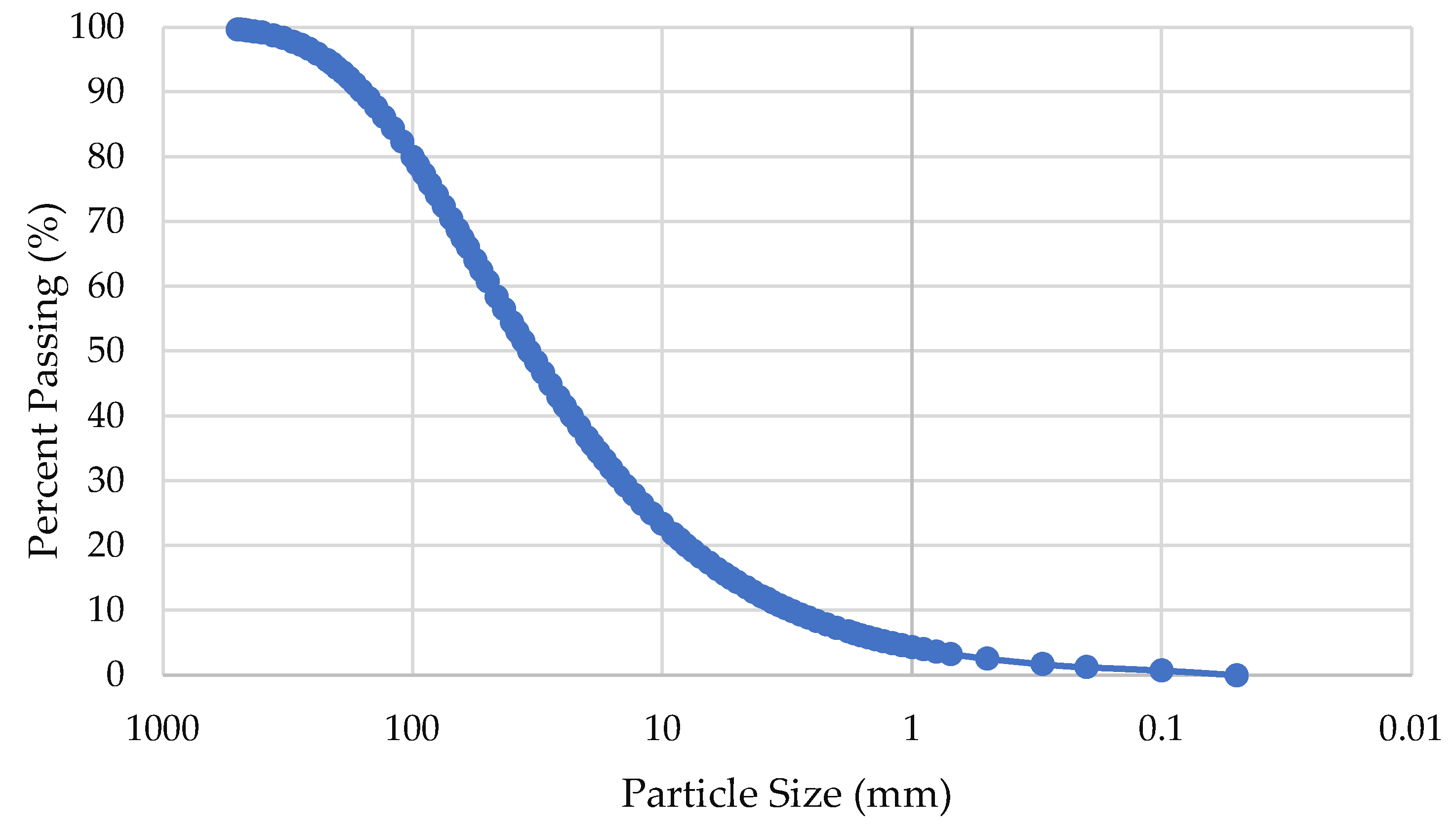
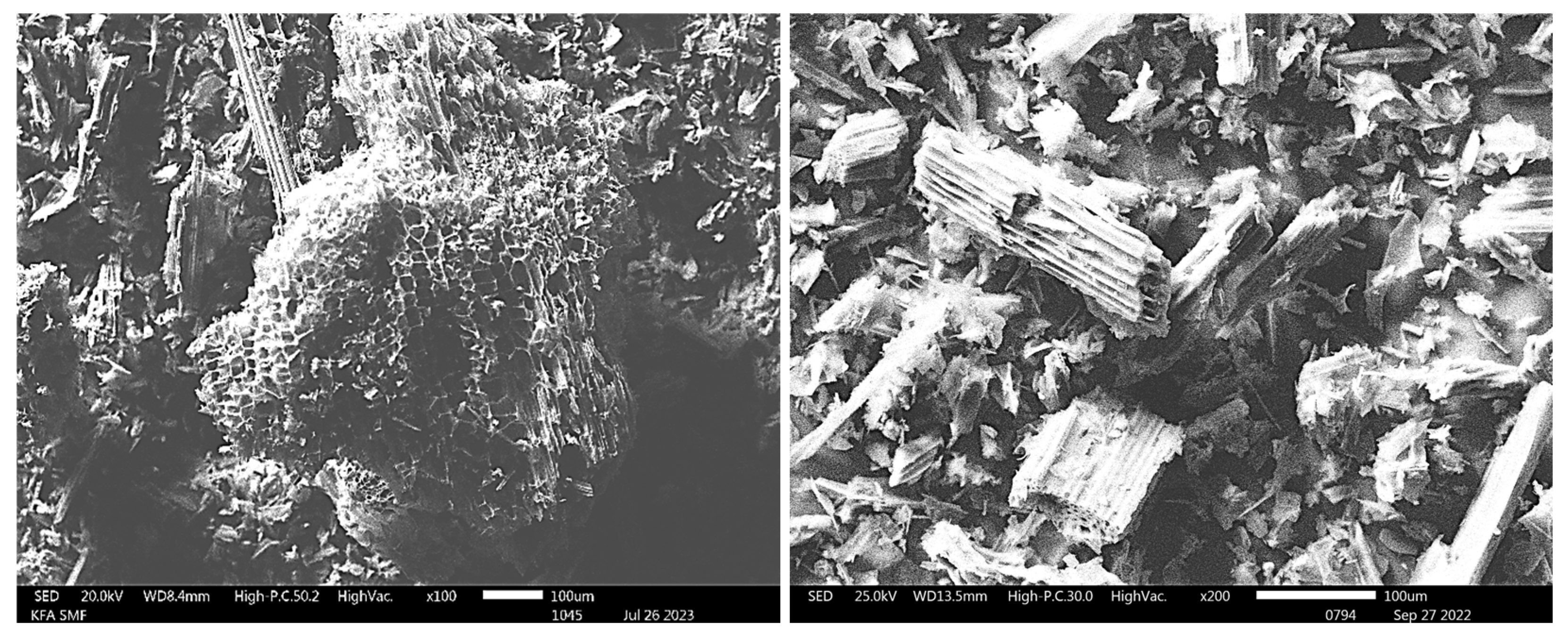
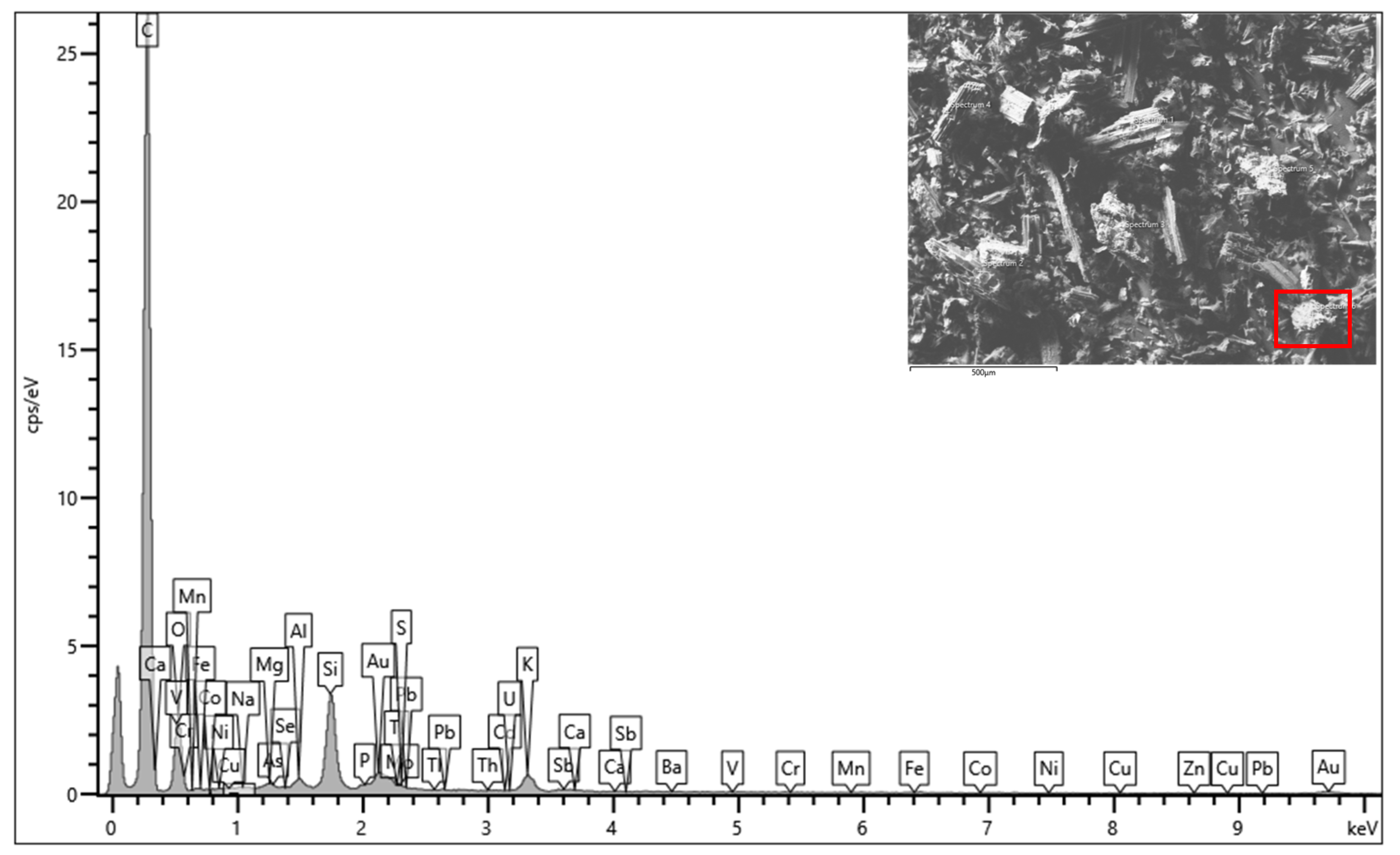
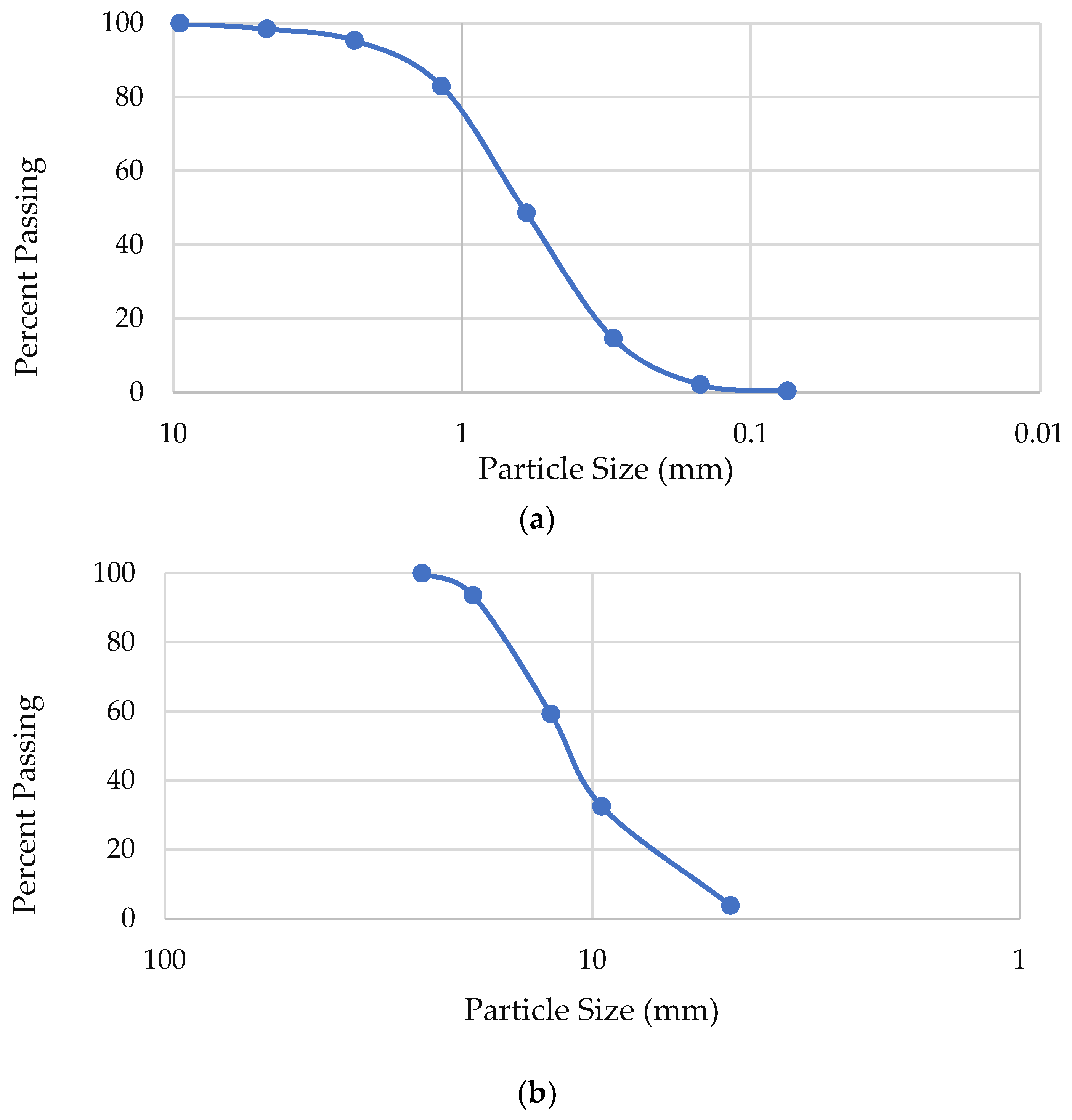
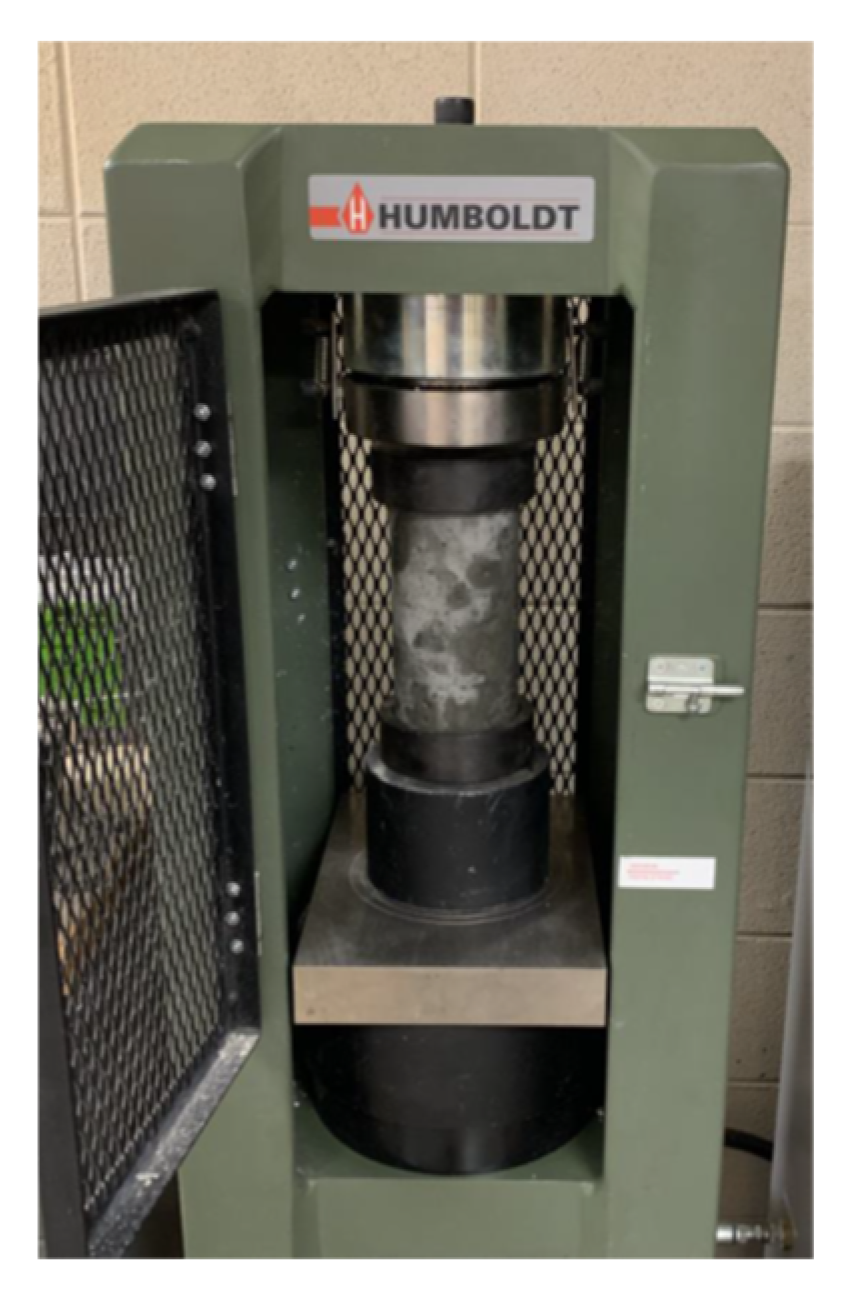
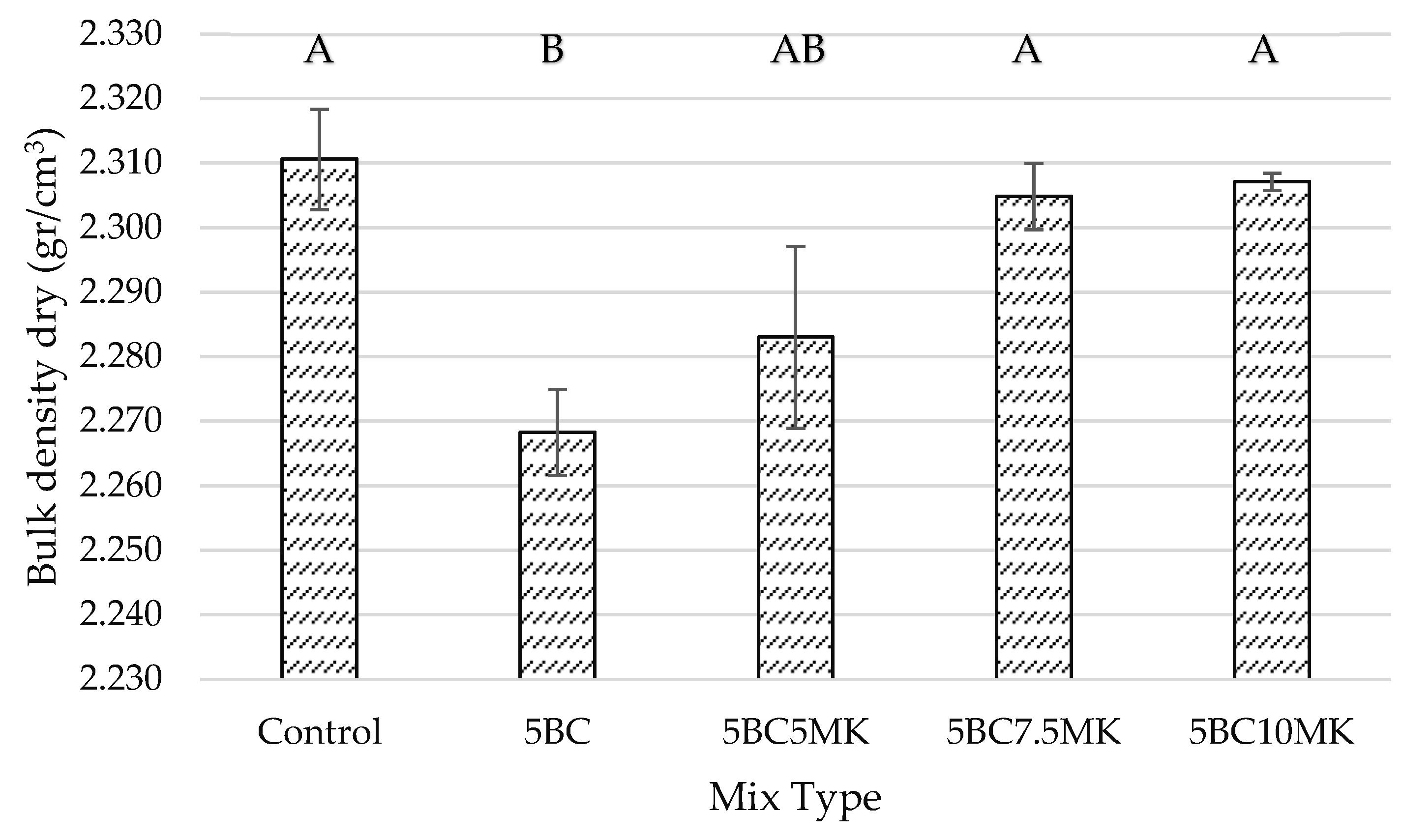
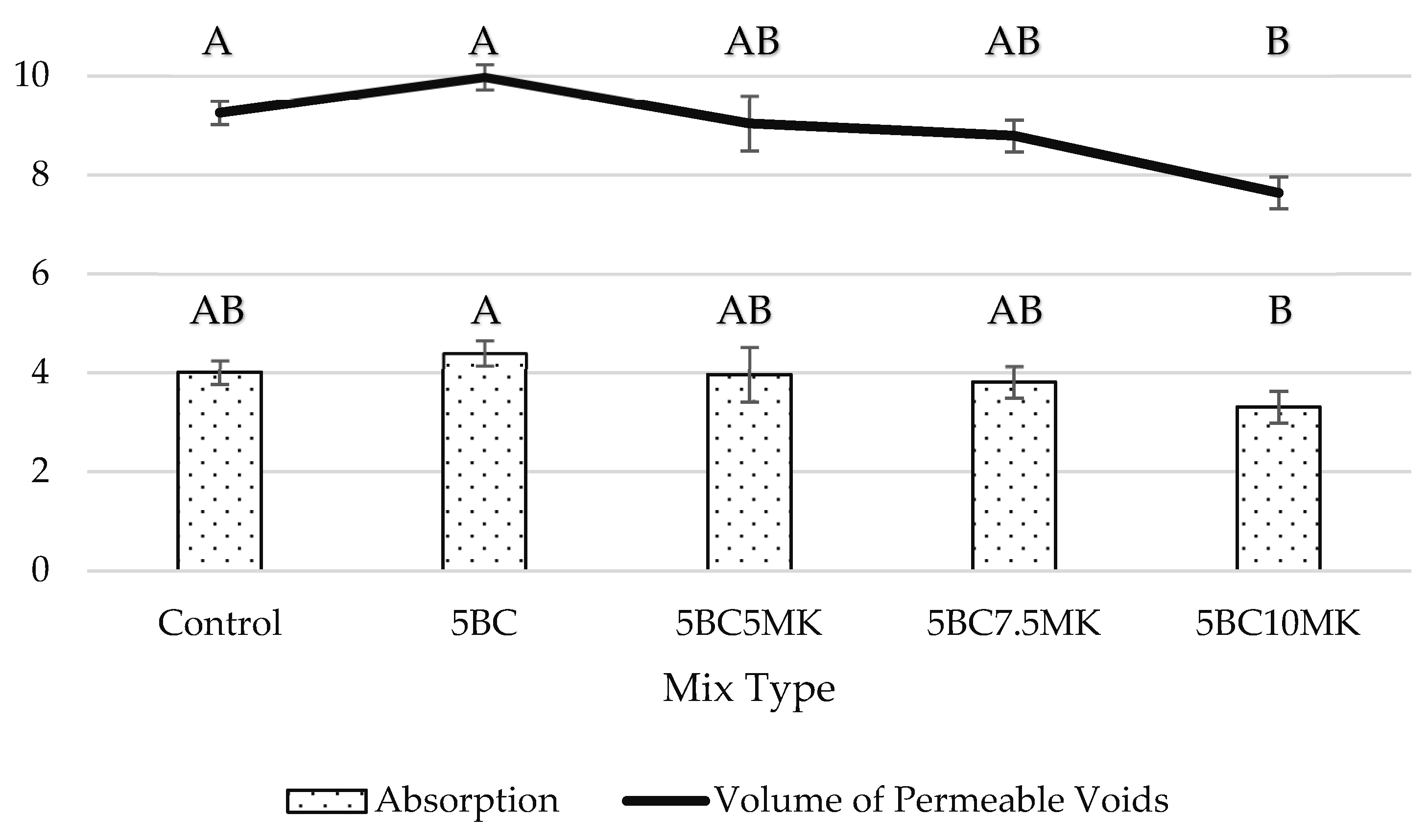
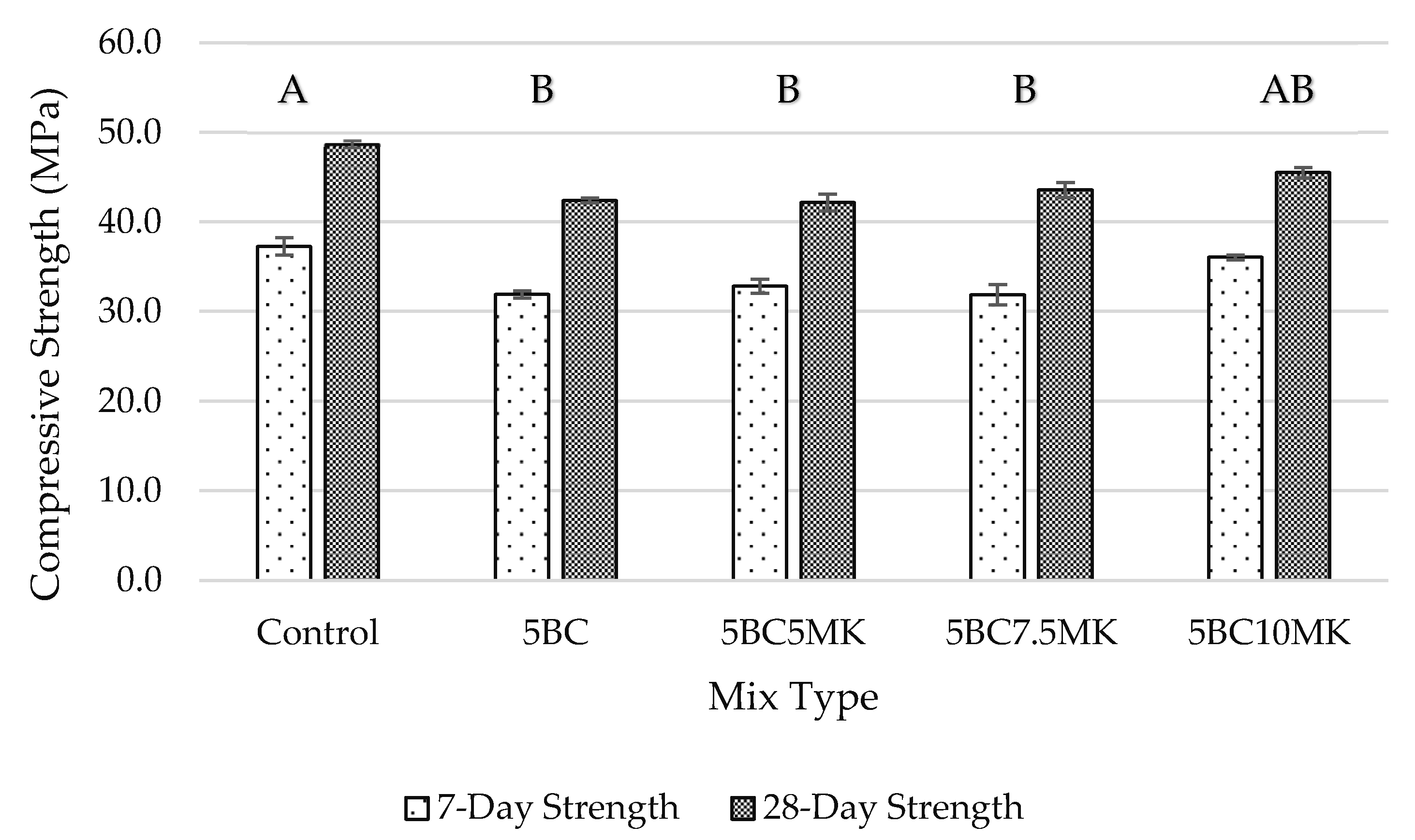
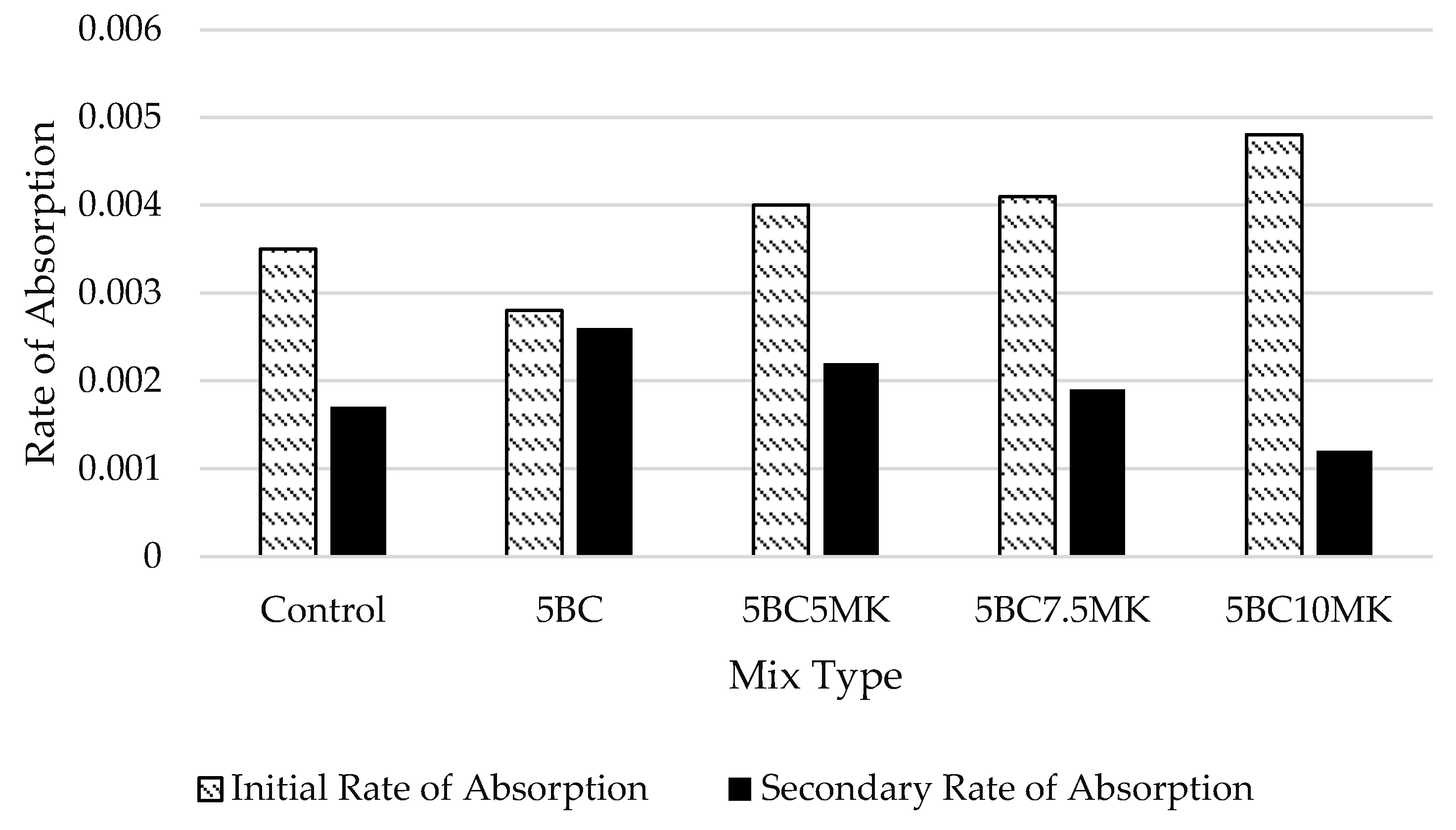

| Density | pH | EC (Electrical Conductivity) | MC% (Moisture Content) | BET Surface Area | BET Pore Width |
|---|---|---|---|---|---|
| 0.2 (gr/cm3) | 8.73 | 0.21 (mS/cm) | 6.7% | 323.351 m2/g | 5.300 nm |
| Element | C | Ca | K | Mg | Fe | P | S | Mn | Al | Na |
|---|---|---|---|---|---|---|---|---|---|---|
| Meas.* | 872,000 | 9080 | 15,900 | 2380 | 2240 | 1760 | 533 | 201 | 338 | 151 |
| XRF Results | |
|---|---|
| Fe2O3 | 2.675 |
| Al2O3 | 9.266 |
| SiO2 | 14.45 |
| Sum of SiO2 + Al2O3 + Fe2O3: 26.391 | |
| CaO | 21.73 |
| K2O | 35.865 |
| P2O5 | 10.731 |
| MnO | 2.262 |
| SO3 | 1.891 |
| TiO2 | 1.13 |
| Name | D10 | D50 | D90 | Mean Size | Span |
|---|---|---|---|---|---|
| µm | µm | µm | µm | µm | |
| G-Biochar 2 min | 2.7337 | 44.4747 | 128.3401 | 57.96 | 2.824 |
| G-Biochar 5 min 2/2 | 1.732 | 12.537 | 77.4207 | 30.388 | 6.037 |
| Specific Gravity | BET m2/g | Bulk Density gr/cm3 | D10 | D50 | D90 |
|---|---|---|---|---|---|
| 2.6 | 15 | 0.3–0.4 | <2.0 µm | <4.5 µm | <25 µm |
| Element Name | % |
|---|---|
| SiO2 | 52–55% |
| Al2O3 | 41–44% |
| Fe2O3 | <1.9% |
| TiO2 | <3.0% |
| SO4 | <0.05% |
| P2O5 | <0.2% |
| CaO | <0.2% |
| MgO | <0.1% |
| NaO2 | <0.05% |
| K2O | <0.75% |
| LOI | <0.5% |
| Element Name | % |
|---|---|
| SiO2 | 20.6% |
| Al2O3 | 4.8% |
| Fe2O3 | 3.7% |
| CaO | 65.2% |
| MgO | 1.2% |
| SO3 | 2.8% |
| LOI | 1.5% |
| Insoluble Residue | 0.10% |
| Alkalies (Na2O eqv.) | 0.46% |
| Potential Compounds | |
| C3S | 64% |
| C2S | 11% |
| C3A | 6% |
| C4AF | 11% |
| Mixture ID | Cement | Water | Sand | Gravel | Biochar | Metakaolin | W/C | W/SCM |
|---|---|---|---|---|---|---|---|---|
| Control | 11.1 | 5.5 | 20.0 | 27.5 | 0 | 0 | 0.5 | 0.5 |
| 5BC | 10.5 | 5.5 | 20.0 | 27.5 | 0.6 | 0 | 0.52 | 0.5 |
| 5BC5MK | 9.9 | 5.5 | 20.0 | 27.5 | 0.6 | 0.6 | 0.55 | 0.5 |
| 5BC7.5MK | 9.7 | 5.5 | 20.0 | 27.5 | 0.6 | 0.8 | 0.57 | 0.5 |
| 5BC10MK | 9.4 | 5.5 | 20.0 | 27.5 | 0.6 | 1.1 | 0.59 | 0.5 |
Disclaimer/Publisher’s Note: The statements, opinions and data contained in all publications are solely those of the individual author(s) and contributor(s) and not of MDPI and/or the editor(s). MDPI and/or the editor(s) disclaim responsibility for any injury to people or property resulting from any ideas, methods, instructions or products referred to in the content. |
© 2024 by the authors. Licensee MDPI, Basel, Switzerland. This article is an open access article distributed under the terms and conditions of the Creative Commons Attribution (CC BY) license (https://creativecommons.org/licenses/by/4.0/).
Share and Cite
Rose, D.; Shirzad, S. Innovations in Green Concrete: Combining Metakaolin and Arundo Grass Biochar for Enhanced Sustainability. Sustainability 2024, 16, 11219. https://doi.org/10.3390/su162411219
Rose D, Shirzad S. Innovations in Green Concrete: Combining Metakaolin and Arundo Grass Biochar for Enhanced Sustainability. Sustainability. 2024; 16(24):11219. https://doi.org/10.3390/su162411219
Chicago/Turabian StyleRose, Daniel, and Sharareh Shirzad. 2024. "Innovations in Green Concrete: Combining Metakaolin and Arundo Grass Biochar for Enhanced Sustainability" Sustainability 16, no. 24: 11219. https://doi.org/10.3390/su162411219
APA StyleRose, D., & Shirzad, S. (2024). Innovations in Green Concrete: Combining Metakaolin and Arundo Grass Biochar for Enhanced Sustainability. Sustainability, 16(24), 11219. https://doi.org/10.3390/su162411219






